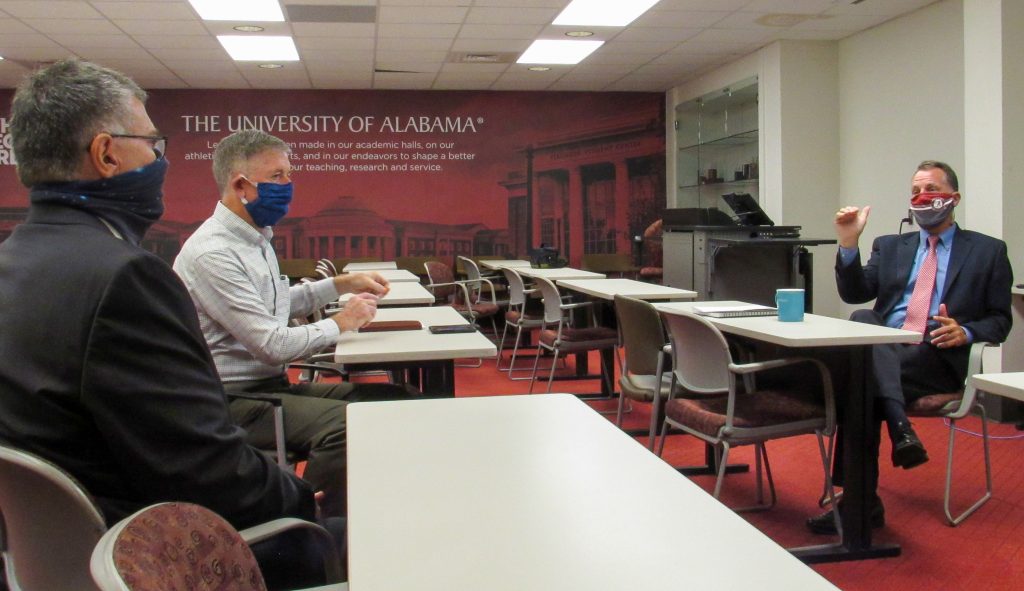
During a recent visit to The University of Alabama, U.S. Geological Survey Director Dr. Jim Reilly touted his vision for USGS Water Resources, as well as what the future holds with its partnership with the Alabama Water Institute.
Reilly met with several members of the UA leadership and faculty members, including an online town hall in which he and USGS Associate Director for Water Resources Dr. Don Cline discussed the agency’s strategy for water.
“Water is the core solvent for any carbon lifeform, so without water we’re pretty well out of luck,” Reilly said. “It is the one agent that is going to stand atop pretty much everything we do.”
Reilly laid out USGS’ goals when it comes to water science strategy. The first is to provide society the information it needs regarding the amount and quality of water in all components of the water cycle, as well as helping understand the processes that determine water availability. As changes in climate, population, land use and management occur, they want to predict variables in the quantity and quality of water resources. He said they also want to elevate anticipation and response to water-related emergencies and strive to deliver timely data, analysis and tools anywhere in the U.S. to support water resource decisions.
USGS operates the largest water observation system in the country with more than 10,000 real-time streamgages, which provide in excess of 80,000 streamflow measurements per year. The agency also observes groundwater conditions at more than 17,000 wells and continuously monitors water quality at 2,100 stations.
With more than 1.2 billion water observation data requests in 2019, they are identifying ways to upgrade their capabilities. Reilly said they are working on the USGS Next Generation Water Observing System, which will gather higher-resolution, real-time data using modernized collection, storage and delivery methods. He said they want to get that data out more quickly to organizations that need it, and it’s becoming more imperative to collaborate with other entities.
“It’s now becoming integrated and will go interagency,” Reilly said. “There are lots of efforts that will go into this work that we’ll combine with NOAA, for example, which is one of the reasons we really like where we’re headed on The University of Alabama campus.”
Within the next few years, the USGS will have a physical home at UA. A new Hydrologic Instrumentation Facility, or H.I.F., will be constructed close to the current location of the AWI and NOAA’s National Water Center.
“It’s important because it’s the backbone of our entire observation framework,” Cline said. “Every instrument we have across the country, the streamgages, the groundwater wells, all the sampling we do, goes through the H.I.F. for tests and calibrations.”
Cline described the H.I.F. as a large hydrological laboratory with a variety of tanks, flumes and groundwater test facilities. It can take any instrument that is designed to measure water and test it to make sure it’s ready to go out into the field. He said it’s part of their national consistency program where all instruments are cross-calibrated against national standards.
Cline said one new feature for the UA-based H.I.F. is a research area as the current building is strictly operational. Included in that new section is a large-scale test water basin which will allow them to build and deconstruct any type of water containment they desire in an internally controlled lab setting.
“It will allow us to test new flow studies or new instrumentation,” said Cline. “It’ll give us many opportunities to innovate and interact with those activities.”
The new building at UA will replace the current H.I.F. in Bay St. Louis, Mississippi.
“The building we’re currently in was built to support the Apollo space program, so it’s pretty old,” said Cline. “We received funding to build a new state-of-the-art facility, so we chose the Tuscaloosa campus.”
Cline said the design process is almost complete, and construction should begin in the summer of 2021. It should be complete by the end of the following year.
